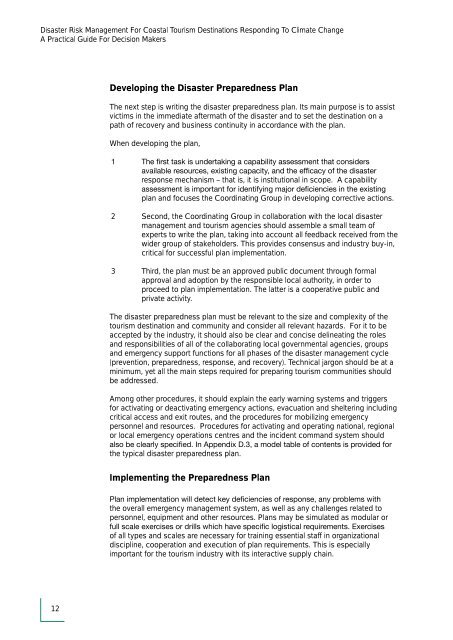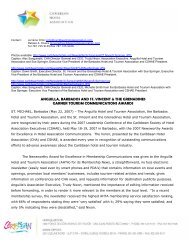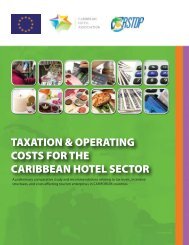Disaster Risk Management for Coastal Tourism - Caribbean Hotel ...
Disaster Risk Management for Coastal Tourism - Caribbean Hotel ...
Disaster Risk Management for Coastal Tourism - Caribbean Hotel ...
You also want an ePaper? Increase the reach of your titles
YUMPU automatically turns print PDFs into web optimized ePapers that Google loves.
<strong>Disaster</strong> <strong>Risk</strong> <strong>Management</strong> For <strong>Coastal</strong> <strong>Tourism</strong> Destinations Responding To Climate Change<br />
A Practical Guide For Decision Makers<br />
Developing the <strong>Disaster</strong> Preparedness Plan<br />
The next step is writing the disaster preparedness plan. Its main purpose is to assist<br />
victims in the immediate aftermath of the disaster and to set the destination on a<br />
path of recovery and business continuity in accordance with the plan.<br />
When developing the plan,<br />
<br />
<br />
<br />
response mechanism – that is, it is institutional in scope. A capability<br />
<br />
plan and focuses the Coordinating Group in developing corrective actions.<br />
2 Second, the Coordinating Group in collaboration with the local disaster<br />
management and tourism agencies should assemble a small team of<br />
experts to write the plan, taking into account all feedback received from the<br />
wider group of stakeholders. This provides consensus and industry buy-in,<br />
critical <strong>for</strong> successful plan implementation.<br />
3 Third, the plan must be an approved public document through <strong>for</strong>mal<br />
approval and adoption by the responsible local authority, in order to<br />
proceed to plan implementation. The latter is a cooperative public and<br />
private activity.<br />
The disaster preparedness plan must be relevant to the size and complexity of the<br />
tourism destination and community and consider all relevant hazards. For it to be<br />
accepted by the industry, it should also be clear and concise delineating the roles<br />
and responsibilities of all of the collaborating local governmental agencies, groups<br />
and emergency support functions <strong>for</strong> all phases of the disaster management cycle<br />
(prevention, preparedness, response, and recovery). Technical jargon should be at a<br />
minimum, yet all the main steps required <strong>for</strong> preparing tourism communities should<br />
be addressed.<br />
Among other procedures, it should explain the early warning systems and triggers<br />
<strong>for</strong> activating or deactivating emergency actions, evacuation and sheltering including<br />
critical access and exit routes, and the procedures <strong>for</strong> mobilizing emergency<br />
personnel and resources. Procedures <strong>for</strong> activating and operating national, regional<br />
or local emergency operations centres and the incident command system should<br />
<br />
the typical disaster preparedness plan.<br />
Implementing the Preparedness Plan<br />
<br />
the overall emergency management system, as well as any challenges related to<br />
personnel, equipment and other resources. Plans may be simulated as modular or<br />
<br />
of all types and scales are necessary <strong>for</strong> training essential staff in organizational<br />
discipline, cooperation and execution of plan requirements. This is especially<br />
important <strong>for</strong> the tourism industry with its interactive supply chain.<br />
12








